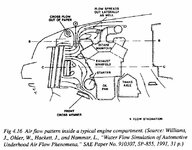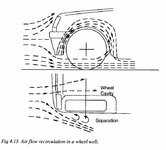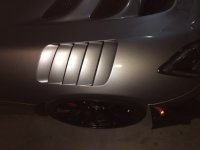My suspicion is (and testing would help - or looking for someone's results)- is that the "uplift" on the hood would act as a gurney-like flap and create a low pressure zone there, just ahead of the windshield, where there is a huge high pressure zone. Sorry, but I haven't seen this testing done on this configuration, smoke, streak, or tuft, let alone wind tunnel. If I come across some documentation I'll bring it on. There was some testing similar on the earlier Grand Sports hood louvers, I'll look for that, and see if there is an analogy.
Sorry, that is a long way to say, maybe - but maybe not. I believe those "should" evacuate air from under hood (and some heat). My radiator on the SR "dumps" like that, minus the grills.
Other examples; Ford GT-40 -- original and new, Factory 5 GTM, many variants of the Ferrari, etc. These analogs make me suspect, reverse flow would be very unlikely on the hood.
Cheers - Jim






